

|
The Harvey Public Domain Cartoons: 1945-1950 |
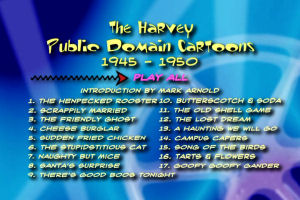 |
This unique collectible can be yours today for only $10.00 (NEW LOW PRICE!). Just click this PayPal button to add this special DVD to your Shopping Cart.



USA CA/MX INTL |
The Harvey Public Domain Cartoons: 1945-1950 Written and Compiled by Mark Arnold This text © 2007 Mark Arnold and Fun Ideas Productions Welcome to the officially "unofficial" HARVEYVILLE FUN TIMES! edition of the public domain
Harveytoons. These 17 cartoons have been collected and recollected on endless tapes and
DVDs over the years, but never with my annotations. What's here are the first six Herman
cartoons (without Katnip); the first three Casper cartoons; the first Buzzy the crow
cartoon (again without Katnip); the first six Little Audrey cartoons; and the first Tommy
Tortoise cartoon (with a prototype Moe Hare). Typically, "Quack a Doodle Doo", "Boo Moon",
"Spooking About Africa", and "Pest Pupil" also seem to make it on those public domain
collections, but as all of these are now available in pristine versions on Classic Media's
HARVEY TOONS - THE COMPLETE COLLECTION DVD set from 2006, there's no point in
repeating them here. In reality, none of those should appear as they were originally
released after August 1950 except "Quack a Doodle Doo".
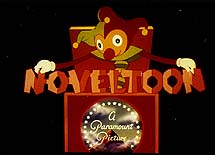
1. THE HENPECKED ROOSTER - February 18, 1944 (Herman cartoon #1) Direction: Seymour Kneitel; Animation: Orestes Calpini, Reuben Grossman; Story: Jack Ward, Jack Mercer; Musical Arrangement: Winston Sharples. Henry Rooster is chewed out by his wife on the farm and told to clean up. "Yes, my love", Henry replies. We cut to "How to Lay an Egg" by Bob Hope, a book Henry's wife is reading while eating candy corn. Herman the mouse appears in the candy and is almost eaten by the wife. In fear, she races to Henry to get rid of the mouse. Herman escapes and even eats the cheese off of a mousetrap as he leaves. Henry outsmarts Herman and captures him in a cage. While discarding Herman, Henry's wife demands that Henry get back to work. Herman works out a deal with Henry to fight back against his wife. Henry shows some backbone and before the wife can clobber him with a rolling pin, Herman comes out to scare the wife. The plan works and Henry is now no longer henpecked. Henry's wife writes a letter to Herman that claims to be from "Mrs. Mouse". Mrs. Mouse DOES show up and takes Herman away. Now Mrs. Rooster rolls up her sleeves to clobber Henry like she wanted to do in the first place. Henry gets the last laugh by wearing a mouse costume and scaring off his wife. It backfires in the end as a hungry cat chases Henry and his wife to the fadeout. This is the only appearance of Herman's wife. 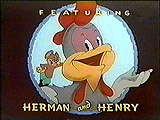
2. SCRAPPILY MARRIED - March 30, 1945 (Herman cartoon #2) Direction: Seymour Kneitel; Animation: Orestes Calpini, Otto Feuer; Story: William Turner, Jack Ward; Musical Arrangement: Winston Sharples. This is a Noveltoon featuring Herman and Henry. This is a definite follow-up to "The Henpecked Rooster". Chicken Pie (his wife now has a name) demands that Henry sit on the eggs while she plays cards. Herman the mouse again appears to torment her and she runs off in fear. With new freedom, Henry plays pool with the eggs. Chicken Pie wants to come back inside but can't bear to be around Herman. This time she uses a cat costume to torment Herman and Henry. Herman acts scared, but then plucks the mask off of Chicken Pie, who then runs off again in fear. Herman and Henry have another good laugh. Soon they see Chicken Pie up to her old tricks, but this time it's a real cat, not Chicken Pie in a costume! Herman runs in fear from the real cat, who ends up trapping Herman in a cage. Henry runs to avoid Chicken Pie's rolling pin. At the last moment, Henry is saved as Chicken Pie again runs in fear. It seems that Herman has switched places with the cat, which is now in the cage and Herman is free. 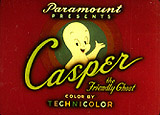
3. THE FRIENDLY GHOST - November 16, 1945 (Casper cartoon #1) Direction: I. (Isadore) Sparber; Animation: Nick Tafuri, John Walworth, Tom Golden; Story Adaptation: Bill Turner, Otto Messmer; Narration: Frank Gallop; Musical Arrangement: Winston Sharpies; Scenics: Shane Miller. Strangely, both Joe Oriolo and Seymour Reit do not get any credit. You may or may not know Frank Gallop from his "Ballad of Irving" record from the comedy LP, "When You're in Love, The Whole World is Jewish". Otto Messmer is the creator of Felix the Cat. John Walworth designed Casper and later designed the Spoonmen for Nabisco's Shredded Wheat and many Cracker Jacks and cereal premiums. The first three Casper cartoons usually are lumped together on a tape. They were never part of the syndicated Casper cartoon series of the 70s and 80s, and are frequently found alone and together on dozens of public domain tapes and DVD's. Why Harvey never included these as part of the syndicated package is because it was made before 1950, but also understandable. The series had not been established yet, and in the case of the first cartoon especially, Casper was designed as a one shot character. All three were part of the Noveltoons series. The Friendly Ghost is the one that started it all over 50 years ago! Take the day off work, November 16! Gallop introduces the film with, "There are some people who believe in ghosts, and there are some people who don't..." We first see Casper asleep. He has been reading "How to Make Friends". (This seems to be a recurring theme in the early cartoons that we find Casper with a book.) At midnight, the ghosts come to life. One ghost tries to convince Casper to scare, to no avail. Casper returns to his book, while the other ghosts fly away to haunt. As a result, Casper decides to run away with his belongings at the end of the stick. In the travels, he (unintentionally) scares a rooster, a mole, a cat, a mouse and some hens. He feels dejected and decides to "end" it all, by having a train run over him. (I presume this is the reason why Harvey didn't want to include this cartoon in the package.) This of course, fails, because (duh!) he's already dead! Soon, a small girl and boy named Bonnie and Johnny retrieve their ball, which has bounced over by the tracks. Not afraid of Casper, they ask him to play ball with them and jump rope. Later, they bring Casper home to mother, scaring her out of her wits. She chases him off. An evil landlord arrives for the mortgage, but when he sees Casper, he's convinced the house is haunted, tears up the deed and runs away. For his help, the mother reconsiders and in the end Casper is sent to school with Bonnie and Johnny. Though this story is sometimes uneven and quite literally doesn't make sense, it is still an enjoyable first effort nonetheless. The animation is the typical high quality that originated from the Famous/Paramount studios in the 40s. There was no hint at the time that Casper would become such a major cartoon superstar, starring in a major feature film 50 years later. 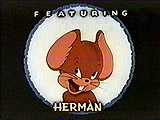
4. CHEESE BURGLAR - February 22, 1946 (Herman cartoon #3) Direction: I. Sparber; Animation: Jim Tyer, Ben Solomon, William Henning; Story: Carl Meyer, Joe Stultz; Musical Arrangement: Winston Sharples. This is a Noveltoon featuring Herman. The cartoon opens with an unnamed cat and dog singing a friendship song called "Dear Old Pal" Herman the mouse breaks up their singing and causes the dog to shoot corks at Herman and secure him in his mouse hole with the cork plugging the hole. Herman complains about 29 days of starvation and crosses off February 29 (Quite interesting as February 1946 only had 28 days.) Herman tightens his belt, corkscrews out the cork and informs the cat and dog that they are natural enemies. The cat and dog laugh at him and after taking another shot at Herman, they get some shuteye. Herman plans his next move, which includes pumping natural gas into the dog's nose from a tube connected to the gas stove. The sleeping cat has a gas mask on (placed by Herman). Dog wakes up and realizes that Herman was right and proceeds to clobber the cat with the backend of the rifle. After being hit, the cat agrees with Herman too and takes a knife to the dog. Dog retaliates with another knife. Herman delights in the mayhem and starts laughing. Cat and dog overhear Herman state that he made them enemies making them friends again and plot against Herman by acting like they killed each other. Herman crosses over the "dead" bodies to the icebox and gets shut inside by both cat and dog. They discover Herman trapped in a bottle and try to drink him out. All three are now drunk in the attempts and in the end the three sing a drunken chorus of "Dear Old Pal". Pretty violent stuff by today's standards and certainly one that Maltin would complain about if this were a Disney cartoon. 5. SUDDEN FRIED CHICKEN - October 18, 1946 (Herman cartoon #4) Direction: Bill Tytla. Animation: Orestes Calpini, Otto Feuer; Story: Carl Myer (sic), Jack Ward; Scenics: Anton Loeb; Musical Arrangement: Winston Sharples. The third and final entry in the Herman, Henry, Chicken Pie trilogy. By this time it is rather trite, but here goes. Herman smokes a discarded cigarette and overhears Henry and Chicken Pie fighting again. Chicken Pie is still terrified of Herman and runs off. Herman convinces Henry to fight in the ring for two rounds against Hogan the champion in order to win the big money prize. Henry succeeds, but not until getting massacred. Chicken Pie is listening on the radio at home and is happy Henry won until he reveals he will be home late after partying. Before Chicken Pie can clobber Henry with the rolling pin, Herman saves the day again until she does away with Herman. Finally, she beats up Henry. At the hospital, Henry shares a room with Hogan who wants to take a second shot, but before he does, Herman and Henry beat a hasty retreat out the window. Pretty violent cartoon overall. 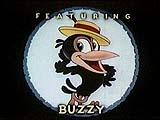
6. THE STUPIDSTITIOUS CAT - April 25, 1947 (Buzzy cartoon #1) Direction: Seymour Kneitel; Animation: Graham Place, John Walworth; Story: Carl Meyer, Jack Ward; Scenics: Anton Loeb; Musical Arrangements: Winston Sharples. This Noveltoon features the first appearance of Buzzy the Crow. A sleeping cat wakes up and makes references to "getting out of the wrong side of bed", "breaking wishbones", and "to whistle before breakfast, cry before dinner". Buzzy appears outside singing "Listen to the Mockingbird" while taking a bath. The cat brings the birdbath inside. Buzzy tries to escape, but the cat captures him. The cat places Buzzy between two slices of bread. Buzzy gets out of the sandwich by informing the cat of "spilling salt". Buzzy then plays with the cat by standing under a ladder, then getting the cat to open up an umbrella inside the house. Finally the cat is really sore and chases Buzzy until he says, "Bread and butter". That is only a temporary solution as he chases Buzzy again and discovers Buzzy by lighting a match. Buzzy has three cigars in his mouth and reminds the cat of "three on a match". In the end the cat breaks a mirror and is informed of seven years bad luck. Buzzy pours ink on the cat, the cat sees himself in the mirror fragment and runs off in fear because he thinks he sees a "black cat crossing his path", not realizing it's him. Buzzy laughs until it is revealed that he too is superstitious when he discovers that it's Friday the 13th! A pretty silly cartoon overall unless you too are superstitious. 7. NAUGHTY BUT MICE - October 10, 1947 (Herman cartoon #5) Direction: Seymour Kneitel; Animation: Dave Tendlar, Al Eugster; Story: Bill Turner, Larry Reilly; Scenics: Robert Owen; Musical Arrangement: Winston Sharples. Herman stars in this cartoon featuring a prototype Katnip. We open on a group of bandaged mice that are starving. Herman shows up to save the day. The new cat is a champion mouse catcher and a photo is shown on the wall. After a short chase, Herman captures the cat in a bag. As the other mice get cheese, the cat escapes, prompting another chase. Herman then traps the cat in a metal milk bottle, and throws him down a well…or so he thinks. After singing a few choruses of "Ding Dong Bell, Pussy's in the Well", Herman realizes he's in the cat's mouth. The cat proceeds to paint Herman with mustard and catsup and sprinkle him with pepper, prompting a sneeze. Herman retaliates with some nearby catnip, which induces hallucinations by the cat. This finally works; the other mice get the cheese, while Herman completes his destruction of the cat by blowing him up. Even that backfires as nine cat ghosts chase Herman in the end! 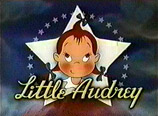
8. SANTA'S SURPRISE - December 5, 1947 (Little Audrey cartoon #1) Direction: Seymour Kneitel; Animation: Myron Waldman, Wm. B. Pattengill; Story Larz Bourne; Music: Winston Sharples; Scenics: Robert Little; Lyrics: Buddy Kaye. Santa sings as he delivers presents to kids around the world including Little Audrey (three stockings on mantle are labeled, "Mom", "Dad", and "Little Audrey"). Audrey and a group of children (a Dutch boy, Japanese girl, black boy, Hawaiian girl, Russian boy and a Spanish girl) journey to the North Pole singing, "We want to do something for Santa". While Santa sleeps, they clean his house (many stereotypical gags including the black boy shining Santa's boots). Santa wakes up and is surprised by his neat home and a wrapped gift. Inside is a must box and a note from the kids: "Dear Santa, Please don't forget us next year!" December 25 is circled on the calendar. (Note: Audrey is not the star of this "Noveltoon", but is lead supporting character.) 9. THERE'S GOOD BOOS TONIGHT - April 23, 1948 (Casper cartoon #2) Direction: 1. Sparber; Animation: Myron Waldman, Morey Reden, Nick Tafuri; Story: Bill Turner, Larry Riley; Scenics: Anton Loeb; Music: Winston Sharpies; Narration: Frank Gallop. 2˝ years after "The Friendly Ghost", this cartoon appeared. It is presumed that first one warranted this cartoon, which is basically a reworking of that first one. "Now isn't this the perfect setting for a spine tingling ghost story," Gallop narrates. For the first and probably only time, a generally scary mood is established in a Casper cartoon. It's shortlived when we discover Casper reading "Animal Friends" in the graveyard. Meanwhile, other ghosts rise out the graves to scare. Casper, as always, wants no part, so in his continual efforts to make friends, scares a calf, a cow and a skunk. After being sprayed, Casper bathes and soon befriends Ferdie Fox. Together they play hide and seek. Soon, foxhunters come on the scene and fire shots. Casper defends Ferdie and scares two dogs, a horse and the hunter. Unfortunately, for Casper, his efforts were in vain as Ferdie had been shot DEAD!! Casper weeps and buries his friend, who soon rises out of the grave as a ghost and they rekindle their friendship! Amazing! This is probably the only time in the history of Casper (barring the feature film), that death and reincarnation is shown in such graphic detail. This is surely the reason why this cartoon was not put in the syndication package. This cartoon is a vast improvement over the first one in that nothing truly illogical (i.e. Casper's suicide) occurs. This also tugs at your heartstrings. Man, when Ferdie rises from the grave, you just want to bawl your eyes out. Sharples music score also enhances this scene. Have the tissues ready! 10. BUTTERSCOTCH AND SODA - July 6, 1948 (Little Audrey cartoon #2) Direction: Seymour Kneitel; Animation: Al Fugster, Bill Hudson, Irving Spector; Story: Larz Bourne, Bill Turner; Scenics: Robert Owen; Music: Winston Sharples; Lyrics: Buddy Kaye. This is really the first "official" Little Audrey cartoon, but all Audrey cartoons were released under the "Noveltoons" banner. Audrey eats candy. Audrey's maid (in her first appearance, who is not given a name in this cartoon, but is later Delilah or Petunia interchangeably) comes in and is upset to find her eating candy instead of food. At the dinner table, Audrey still sneaks candy and feeds food to the dog (Pal?) until the maid stops it and sends Audrey to her room without candy. Audrey searches for her hidden candy. Candy is hidden in a lamp above a la "Lost Weekend", but a mouse has eaten it. Soon, Audrey goes through candy withdrawal and ends up in Candyland. (Visual joke in Candyland: "I'd walk a mile for a caramel.") Eventually, Audrey eats too much candy and gets sick. The candies sing "Tummy Ache Blues", as candy is liberally poured into Audrey's mouth, she wakes up to find the maid washing Audrey's face. The maid has second thoughts and gives Audrey some candy, which scares Audrey off. Soon, dog is eating candy and Audrey eats food. 11. THE OLD SHELL GAME - December 17, 1948 (Tommy & Moe cartoon #1) Direction: Seymour Kneitel; Animation: Dave Tendlar, Tom Golden; Story: Joe Stultz, Larry Riley; Scenics: Robert Connavale; Musical Arrangement: Winston Sharples. The "Bert Lahr" wolf lurks around the forest looking for some food. He spots a young calf and dreams of Porterhouse, T-bone, sirloin and round steak. He prepares to dine and sharpens his utensils when an angry bull stops him. The wolf escapes in his bag with the bull chasing him. The bull butts him, knives fly everywhere and the wolf is soon pinned to a tree by his own knives and almost loses his head. Wolf is still increasingly hungry. We cut to Tommy Tortoise playing checkers with himself on his shell. The wolf is still dreaming of steak and decides to have "turtle" steak. Tommy is still playing checkers as the wolf takes him away. Tommy bites the wolf on the nose and gets away, but the wolf captures him with a fishing line. While Tommy is tied up, the wolf reads how to prepare his steak from a cookbook. While he tries to remove Tommy from his shell, the wolf's hands get caught in a mousetrap. The wolf tries again and pulls out paper dolls, a number of flags, laundry, the kitchen sink, and eventually his own leg and bites his own foot thinking it is a sandwich. A dog selling ice cream passes by. Both the wolf and Tommy order ice creams. The dog says, "That'll be 20c for two." The wolf says, "For two?!" and goes after Tommy again. The wolf resorts to shooting Tommy out, but Tommy retaliates with a cannon. Finally, after a couple of more attempts, the wolf gets Tommy into a boiling pot. Meanwhile, in the cartoon's most surreal moment, an unnamed hare (who really doesn't look like Moe Hare, but is a hare nonetheless) rolls back the scene and asks, "Hey Murgatroid, where've you been?" to which Tommy (Murgatroid) responds, "Whoops, pardon me, I'm in the wrong picture," and they both escape to a "Tortoise and the Hare" cartoon. The wolf is left crying, his tears cause a passing worm to open an umbrella and the chase cycle begins again with the wolf now pursuing the worm. 12. THE LOST DREAM - March 18, 1949 (Little Audrey cartoon #3) Directed by Bill Tytla. Little Audrey is reading by moonlight, when Delilah the maid comes in and admonishes her: "Moonlight will give you bad dreams!" Audrey goes to bed and dreams of Candyland, Lemonade Lakes and money raining from the sky. One of her dream rain clouds morphs into a dream pixie, a "lost dream" that has missed the last boat to Dreamland. Audrey's dream-self volunteers to take him back on a moonbeam to Dreamland. They report to the Sandman, and he gives the OK for the little pixie to give Audrey a grand tour of Dreamland, but warns her not to go near "the black door". They see the usual Famous Studios pun gags: a "cat nap", and man who sleeps "like a top", look into faded dreams, broken dreams, pipe dreams and girls & boys dream (a school being burnt down). Audrey opens the black door and lets loose Nightmare creatures and is chased by floating heads and dragons. Audrey awakens and furiously boards up her windows to keep the moonlight out. 13. A HAUNTING WE WILL GO - May 13, 1949 (Casper cartoon #3) Direction: Seymour Kneitel; Animation: Myron Waldman, Irving Dressier; Story by Larz Bourne; Musical Arrangement: Winston Sharpies; Scenics: Anton Loeb; Narration: Frank Gallop. They're getting faster with these, so a series must be imminent. Only a year has passed since the last cartoon. "I don't think anyone ever really believes in ghosts or ghost stories...," Gallop begins this tale. The setting is an abandoned schoolhouse where a ghost school is in progress. In class, the ghosts sing the title theme. We find Casper who, naturally, is wearing a dunce cap. After class is dismissed, Casper tries to make friends and scares a turtle, a pelican, a fish and some ducks in the process. Upset, Casper inadvertently sits on an egg and hatches it. Out pops Dudley the duck. As friends, Casper mothers Dudley, teaching him to swim and fly. Dudley sees a decoy duck. A hunter shoots, and as in "There's Good Boos", Casper scares away the hunter and his dog. This time, however, Dudley is believe dead, but really isn't. Happy day! This cartoon plays almost verbatim to "There's Good Boos", but is not as effective. Also, Dudley is so obnoxiously cute, as to be annoying. At least he doesn't have a voice like Yakky Doodle to match. 14. CAMPUS CAPERS - July 1, 1949 (Herman cartoon #6) Direction: Bill Tytla; Animation: George Germanetti, Steve Muffatti; Story: Carl Meyer, Jack Mercer; Scenics: Robert Connavale; Music: Winston Sharples. This is a Noveltoon featuring Herman. "Hit 'em High, Harbard" is the song we open up on for the Class of 1940, the Class of 1920 and the Class of 1900. Knucklehead the Cat crashes this soire and the mice scat. Then Herman rides up hanging on to the hood ornament. As typical in later Herman & Katnip cartoons, he states that he will help the other mice defeat the cat. Knucklehead sings his "Quinston" Alma Mater when Herman tackles him with a watermelon. The cat retaliates by trying to put Herman through the meat slicer, but Herman gets the last laugh as usual. After running through the recreation room, Herman bowls the cat out to thunderous cheers by the other mice. But Knucklehead has the last laugh and traps Herman. Then it's Herman's turn. He flattens Knucklehead with a pool table and the mice cheer again. Knucklehead gets the upper hand yet again and makes a Herman sandwich. To get out of this fix, Herman sings the "Quinston" Alma Mater again and finally wheels Knucklehead out of the picture. Nothing much, but the stage has been set for further Herman & Katnip films with Katnip. 15. SONG OF THE BIRDS - November 18, 1949 (Little Audrey cartoon #4) Direction: Bill Tytla; Animation: George Germanetti, Steve Muffatti; Story: Bill Turner, Larry Riley; Scenics: Robert Little; Music: Winston Sharples. Audrey shoots a gun at a pan strapped to her dog's tail. Delilah is sleeping in the kitchen, but soon kicks Audrey out for her careless gunplay. Audrey goes outside and shoots at things, including a mother bird's baby. Audrey is shocked that she killed the baby. At night, all the birds hold a huge funeral service. All the animals cry, as does Audrey, who watches from her bedroom window. Soon it starts raining and the baby bird is miraculously revived. Everyone is happy, but when Audrey goes out, the birds fly away. Audrey destroys the gun and tries to befriend the birds. Baby bird goes first and soon Audrey has made amends with all the birds. 16. TARTS AND FLOWERS - May 26, 1950 (Little Audrey cartoon #5) Direction: Bill Tytla; Animation: George Germanetti, Steve Muffatti; Story: Bill Turner, Larry Riley; Scenics: Robert Little; Music: Winston Sharples. Audrey listens to a radio show on how to bake a cake. Audrey follows the directions and gets exhausted. While she rests, a gingerbread man pops out of the oven. Audrey chases him to Cakeland. Ginger's bride-to-be is Miss Angel Food Cake. All the cakes sing, "It's a Gay Holiday". The wedding goes without a hitch until Devil's Food Cake shows up. The "cop" cakes are called to rescue Angel. Ginger rides on animal crackers to chase him. Audrey whips the Old Milk Stream into butter and Ginger runs over and battles Devil, gets Angel back, and Devil is taken to jail. Ginger and Angel are finally married. Audrey wakes up from her dream to discover Ginger and Angel in the cake pan with two kids, prompting Audrey's typical closing laugh. 17. GOOFY GOOFY GANDER - August 18, 1950 (Little Audrey cartoon #6) Direction: Bill Tytla; Animation: George Germanetti, Steve Muffatti; Story: I. Klein; Scenics: Anton Loeb; Music: Winston Sharples. Audrey's class recites Mother Goose Rhymes in class. Audrey is bored and reads comics instead. When called to recite, Audrey reads her comic aloud. Audrey is sent to the corner where she falls asleep and has a dream about Mother Goose Land. Mother Goose sings "Little Boy Blue" jazz-style. "Mary Had a Little Lamb" is sung next with humorous lyrics. Next, Tommy Tucker sings for his supper, a la Sinatra. A pig recites a penny verse when the two crooks from Audrey's comic come to steal them. At a fair, a goose lays golden eggs. The crooks steal these, too. Humpty Dumpty (Edward G. Robinson) and Old Woman in Shoe are seen, when Audrey catches the crooks and is shown in class acting out her dream. Teacher wakes her up and Audrey scats some Goose verse with a little bird and does her requisite closing laugh. |
| Fun Ideas Productions -- Multi-Media Print and Video Mark D. Arnold, Writer, Artist, Sales, Video Production |
|||
| Copyright © 2014 Mark's Harvey Comics & Cartoons |
|||